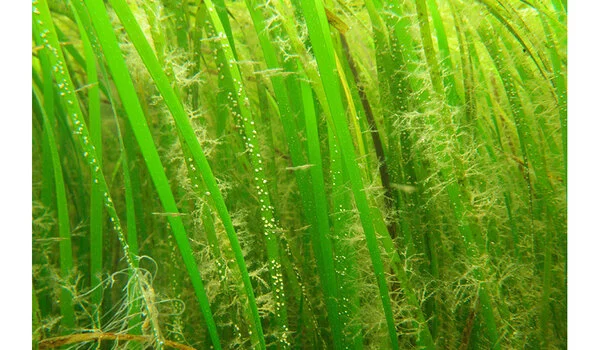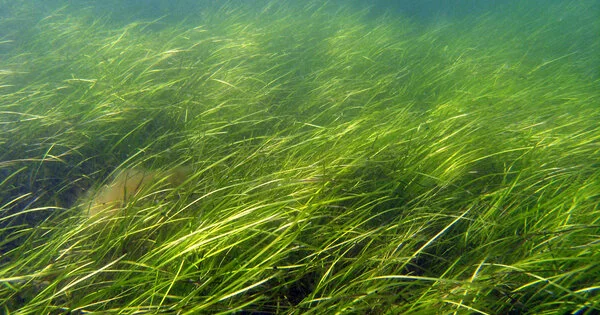In the classic ‘nature versus nurture’ debate, scientists discovered that ancient ice ages shaped the genetics of eelgrasses today – and that those genetics may be more important than the environment in shaping how eelgrasses respond to threats.
Deep evolution casts a longer shadow than previously thought, according to a new paper published in the Proceedings of the National Academy of Sciences. Smithsonian scientists and colleagues studied eelgrass communities, which are the foundation of many coastal marine food webs along the north Atlantic and Pacific coasts, and discovered that their ancient genetic history can play a stronger role in determining their size, structure, and who lives in them than the present-day environment. And this could have implications for how well eelgrasses adapt to threats like climate change.
Some eelgrass plants made the difficult journey from their homes in the Pacific to the Atlantic about a half-million years ago, when the world was warmer. Not all of the plants were tough enough to survive the journey across the Arctic. A series of ice ages during the Pleistocene Epoch influenced how far those that succeeded could spread. Even today, eelgrass populations in the Atlantic are far less genetically diverse than those in the Pacific, owing to millennia of struggle.
Nonetheless, in the classic “nature versus nurture” debate, scientists were astounded to discover that genetic legacy can sometimes shape modern eelgrass communities more than the current environment.
“We already knew that there was big genetic separation between the oceans, but I don’t think any of us ever dreamed that that would be more important than environmental conditions,” said Emmett Duffy, marine biologist with the Smithsonian Environmental Research Center and lead author of the report. “That was a big surprise to everybody.”
Diversity is like having different tools in your tool belt. If all you have is a hammer, you can put nails in, but that’s about it. However, if you have a complete set of tools, each tool can be used to perform different tasks more efficiently.
Jay Stachowicz
Eelgrasses in Hot Water
Eelgrass is one of the most common shallow-water plants on the planet. Its range extends from semi-tropical regions such as Baja California to Alaska and the Arctic. Eelgrass provides a variety of services to humans in addition to food and habitat for many sea creatures. It protects coastlines from storms, absorbs carbon, and has the potential to reduce harmful bacteria in the water.
However, in most areas where it grows, eelgrass is the dominant – or only – seagrass species. As a result, the survival of the people and animals who live there is critical. Furthermore, the Atlantic’s lower genetic diversity may make it difficult for some populations to adapt to sudden changes.
“Diversity is like having different tools in your tool belt,” said co-author and ecologist Jay Stachowicz of the University of California, Davis. “If all you have is a hammer, you can put nails in, but that’s about it. However, if you have a complete set of tools, each tool can be used to perform different tasks more efficiently.”
Ecologists have already observed eelgrass disappearing in some areas as the waters warm. Eelgrass has begun to pull back and move north, into cooler waters, in Portugal, Europe’s southernmost spot.
“I don’t think that we’re going to lose [eelgrass] in the sense of an extinction,” said co-author Jeanine Olsen, an emeritus professor at the University of Groningen in the Netherlands. “It’s not going to be like that. It’s got lots of tricks up its sleeve.” But local extinctions, she pointed out, are going to occur in some places. That could leave regions that depend on their local eelgrass in trouble.

Reaching a More ZEN Worldview
Recognizing the critical need to understand and conserve eelgrass around the world, Duffy and his colleagues formed the ZEN global network. Zostera Experimental Network is a play on the scientific name for eelgrass, Zostera marina. The plan was to bring together seagrass scientists from around the world to conduct the same experiments and surveys in order to obtain a coordinated global picture of seagrass health.
The team studied eelgrass communities at 50 locations in the Atlantic and Pacific for the new study. The team collected data from 1,000 eelgrass plots after sampling 20 plots per site.
They began by gathering basic eelgrass data, such as size, shape, total biomass, and the various animals and algae that live on and around them. They then gathered genetic information from all of the eelgrass populations. They also measured several environmental variables at each site, including temperature, saltiness of the water, and nutrient availability, to name a few.
Finally, they hoped to determine which factor influenced eelgrass communities more: the environment or genetics. They discovered a slew of differences between the Atlantic and Pacific eelgrass ecosystems after running a series of models, differences that closely corresponded to genetic divergence from the Pleistocene migration and subsequent ice ages.
While Pacific eelgrasses frequently grew in “forests” that regularly exceeded 3 feet tall and sometimes reached more than twice that height, the Atlantic hosted more diminutive “meadows” that rarely came close to that height. The genetic differences were also related to the total biomass of eelgrass. Evolutionary genetics and the current environment both played important roles in eelgrass biomass in the Atlantic. In the Pacific, genetics had the upper hand.
These effects spread to other parts of the ecosystem as well. When it came to small animals that lived in eelgrass, such as invertebrates, the Pleistocene genetic signature played a stronger role than the environment in the Pacific – while the two played equally strong roles in the Atlantic.
“The ancient legacy of this Pleistocene migration and bottleneck of eelgrass into the Atlantic has had consequences for the structure of the ecosystem 10,000 years later,” Duffy said. “Probably more than 10,000.”
Conserving The Future
Because ancient genetics can play such a strong role – sometimes stronger than the environment – some ecologists are concerned about eelgrass’s ability to adapt to more rapid changes. “Climate change is probably not the primary threat to eelgrass,” Olsen said. Pollution from cities and farms endangers seagrasses by clouding the water and causing harmful algal blooms. Nonetheless, the wide range of environments in which eelgrass can survive attests to its adaptability.
“I’m optimistic because our findings show long-term resiliency to repeated, major changes in thermal tolerances and the diversity of eelgrass habitats across roughly half of the Northern Hemisphere,” Olsen said. “With the genomic resources now available for eelgrass, we are beginning to analyze functional changes in genes and their regulation in real time. It’s very exciting.”
Maintaining current diversity is a good first step toward protecting existing eelgrass beds. Restoration holds some promise in areas where eelgrass beds have already been lost. Some success stories already exist, such as on Virginia’s eastern shore. However, many restoration efforts are only partially successful. As Stachowicz pointed out, this raises new concerns.
“Should you restore seagrass using plants from local environments, or should you think ahead and try plants with genetics better suited to future environmental conditions?” he wondered. “Or should you take a chance?” Maintaining or improving genetic diversity may be the best way to provide seagrass populations with the diverse toolkit required to survive in an uncertain future.





